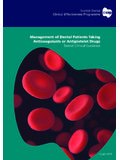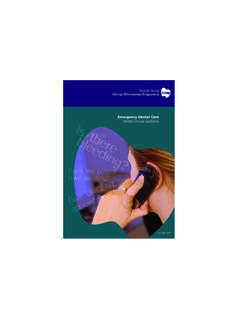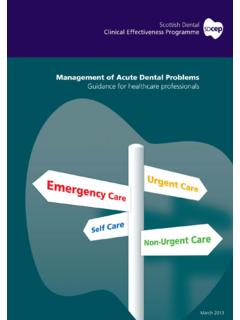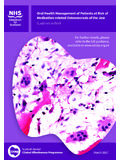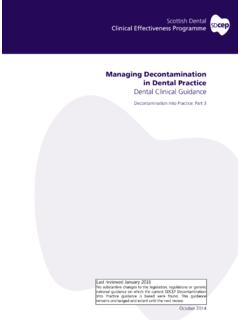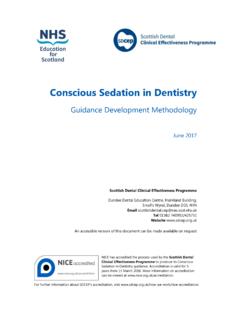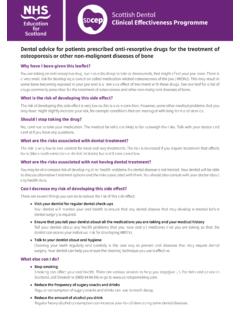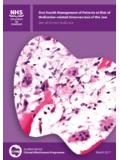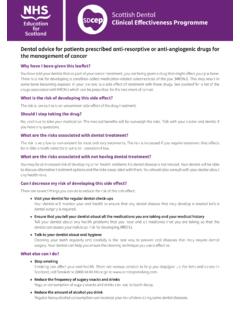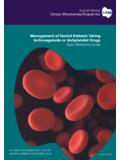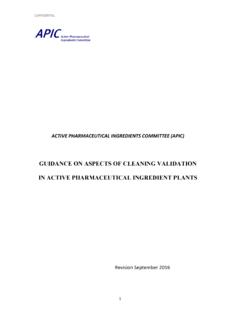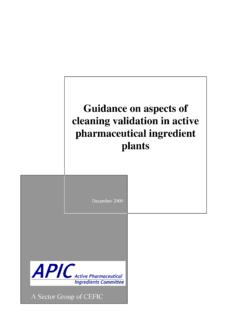Transcription of Scottish Dental cep Clinical Effectiveness Programme
1 cleaning of Dental InstrumentsDental Clinical GuidanceSecond EditionThe Scottish Dental Clinical Effectiveness Programme (SDCEP) is an initiative of the National Dental Advisory Committee in partnership with NHS Education for Scotland. The Programme aims to provide user-friendly, evidence-based guidance on topics identified as priorities for oral health guidance aims to support improvements in patient care by bringing together, in a structured manner, the best available information that is relevant to the topic, and presenting this information in a form that can be interpreted easily and of Dental Instruments is the first part of the SDCEP series Decontamination Into Practice, which aims to support compliance with relevant statutory and mandatory requirements and standards. cleaning of Dental Instruments provides advice on all aspects of cleaning , including organisation within the local decontamination unit, cleaning methods and testing of equipment.
2 Scottish Dental Clinical Effectiveness ProgrammeSDCEP operates within NHS Education for Scotland. You may copy or reproduce the information in this document for use within NHS Scotland and for non-commercial educational purposes. Use of this document for commercial purpose is permitted only with written 978 1 905829 20 0 Scottish Dental Clinical Effectiveness ProgrammeDundee Dental Education Centre, Frankland Building, Small s Wynd, Dundee DD1 4 HNEmail 01382 425751 / 425771 Website DentalClinical Effectiveness ProgrammeSDcepOctober 2014 Scottish DentalClinical Effectiveness ProgrammeSDcepThe Scottish Dental Clinical Effectiveness Programme (SDCEP) is an initiative of the National Dental Advisory Committee (NDAC) in partnership with NHS Education for Scotland. The Programme provides user-friendly, evidence-based guidance on topics identified as priorities for oral health guidance aims to support improvements in patient care by bringing together, in a structured manner, the best available information that is relevant to the topic and presenting this information in a form that can be interpreted easily and implemented.
3 Supporting the provision of safe, effective, person-centred DentalClinical Effectiveness ProgrammeSDcepCleaning of Dental InstrumentsDental Clinical GuidanceSecond EditionDecontamination Into Practice: Part 1 October 2014 Scottish Dental Clinical Effectiveness ProgrammeSDCEP operates within NHS Education for Scotland. You may copy or reproduce the information in this document for use within NHS Scotland and for non-commercial educational purposes. Use of this document for commercial purpose is permitted only with written 978 1 905829 20 0 First published 2007 Second edition published October 2014 Scottish Dental Clinical Effectiveness ProgrammeDundee Dental Education Centre, Frankland Building, Small s Wynd, Dundee DD1 4 HNEmail 01382 425751 / 425771 Website of Dental Instruments1 Introduction 12 Organising cleaning Within the Local Decontamination Unit 2 Purchasing Instruments and Training Staff 2 Setting Up a Local Decontamination Unit 2 Hand Hygiene 4 Good Practice Points 43 Before cleaning 6 During Treatment 6 Taking Instruments to the Local Decontamination Unit 6 Segregating Instruments 7 Items for Disposal 8 Reusable Instruments 9 Items Unsuitable for Immersion 94 cleaning Methods 10 General Requirements 10 Washer-disinfectors 11 Points to Consider Before Purchasing a Washer-disinfector 12 Using a Washer-disinfector 13 Ultrasonic cleaning 14 Points to Consider Before Purchasing an Ultrasonic Cleaner 15 Ultrasonic cleaning Procedure 15 Manual cleaning 17 Workflow and Facilities 17
4 cleaning Procedure 17 Avoiding Instrument Damage 185 Rinsing, Drying, Inspection and Care of Instruments 19 Rinsing and Drying of Instruments after cleaning 19 Inspection and Care of Instruments before Sterilizing 19 Inspection for Cleanliness and Functionality 19 Lubrication 20 Handpiece Care 20 Out-of-hours Use of Instruments 216 Validation, Periodic Testing and Maintenance of cleaning Equipment 22 Washer-disinfectors 22 Installation and Validation22 Testing 22 Housekeeping and Maintenance 24 Ultrasonic Cleaners 25 Installation and validation 25 Testing 25 Housekeeping and Maintenance 25 cleaning of Dental InstrumentsivCleaning of Dental Instruments1 cleaning of Dental InstrumentsDecontamination Into Practice is part of a national initiative to promote and standardise good instrument decontamination practice in Dental primary decontamination is a complex multistage process and an important element of infection control.
5 Effective cleaning is fundamental within the decontamination process and is essential to enable the subsequent disinfection and sterilization of instruments to be carried out reliably. Any organic material or adherent Dental materials left on instruments can inhibit these processes. This can also cause corrosion of instruments or impair their function, and might lead to transmission of infection from one patient to another. Aimed specifically at those working in primary care Dental services, cleaning of Dental Instruments presents practical advice on the first stage of the decontamination process: how to thoroughly clean Dental instruments. This advice is based on a range of existing guidance documents and was first developed in consultation with the Health Protection Scotland (HPS) Decontamination Team (now within Health Facilities Scotland), other experts and information that relates to the whole decontamination process is provided separately in the introduction and appendices of the Decontamination Into Practice series.
6 Many of the weblinks included can be accessed via the Decontamination section of the Scottish Dental website: In particular, the following Scottish Health Technical Memoranda (SHTM) provide technical guidance on how to choose, use and validate equipment for decontamination processes: SHTM 2010 Sterilization SHTM 2030 Washer-Disinfectors (also includes ultrasonic cleaning machines)1 IntroductionCleaning of Dental Instruments22 Organising cleaning Within the Local Decontamination Unit Purchasing Instruments and Training Staff Before buying instruments: check the manufacturer s decontamination instructions to ensure that the instruments can be decontaminated with the equipment and facilities that you have available, or buy single-use instruments; give preference to buying instruments that can be cleaned using a washer-disinfector.
7 Train all staff in the basics of infection control procedures, including: how infections are transmitted; how to prevent transmission of infections; what to do in the event of an accident or personal injury; your practice policy on infection control. Ensure staff are fully vaccinated against hepatitis B. For staff involved in cleaning instruments, give practical training in all stages of the decontamination process. Record and retain details of all staff training. Ensure personal protective equipment (PPE) ( gloves, protective facewear, eye protection, plastic disposable aprons and adequate footwear) is available and worn. Setting Up a Local Decontamination UnitWhen setting up new premises or planning significant modification to existing premises, if space allows, a local decontamination unit (LDU) separate from the patient treatment area(s) that comprises two rooms should be considered: one for dirty activity (the Wash Room) and one for clean activity (inspection, sterilization and wrapping instruments the Sterilization Room).
8 A single room LDU is acceptable for general Dental practice. In this situation, as the clean and dirty activity is undertaken in the same room, tight procedural control is single room LDU preferably comprises a single run of sealed, easily cleaned worktop with the following items arranged in the order listed: a separate hand-washing facility with PPE storage; a setting-down area for dirty instruments; a washing sink with detergent for cleaning instruments; a setting-down area for washed instruments; an ultrasonic cleaner, if appropriate (see Sections 4 and 6); a rinsing sink; cleaning of Dental Instruments3 cleaning of Dental Instruments a setting-down area for rinsed instruments; an automated washer-disinfector (includes drying cycle); a setting-down area with task lighting and magnifier for inspection of all instruments and, if appropriate a Dental handpiece lubricator (see Section ); an area for wrapping instruments (only if a vacuum sterilizer is to be used); a steam sterilizer; an area for setting down and wrapping instruments sterilized in a non-vacuum sterilizer.
9 Instruments are stored prior to use in a clean, orderly, enclosed storage area (not open shelving that ideally is located in an area separate from the LDU. There should be a specific area for administration. Use a dedicated decontamination unit, separated from the patient treatment area, in another room or rooms. Carry out the decontamination process as a dirty-to-clean workflow that ensures dirty instruments or splashes or aerosols generated during cleaning do not come into contact with clean instruments. This is a one-way process achieved by physical segregation of the dirty and clean activities. Irrespective of the specific layout, a tidy working environment makes carrying out decontamination easier. Therefore, declutter your working environment. Within the decontamination unit, maintain air flow so as to reduce the risk of carrying contaminants from the dirty area to the clean area.)
10 Do not use portable fans in the decontamination area because rapid uncontrolled air circulation can spread contamination. Document the practice s arrangements for decontamination. This could be a dedicated decontamination policy or part of the practice s infection control policy and should provide details of the facilities, staff training, instrument transport within the practice, instrument cleaning and inspection, instrument sterilization, equipment testing and maintenance and the management of decontamination failures. More detailed information on planning a LDU, including basic ventilation requirements, is provided in Scottish Health Planning Note 13 Part 2 Decontamination Facilities: Local Decontamination Units (2008) and Compliant Dental Local Decontamination Units in Scotland (Primary Care) (2013).2 Organising cleaning Within the Local Decontamination Unit cleaning of Dental Hand Hygiene Hand hygiene is crucial in preventing the spread of infection.
